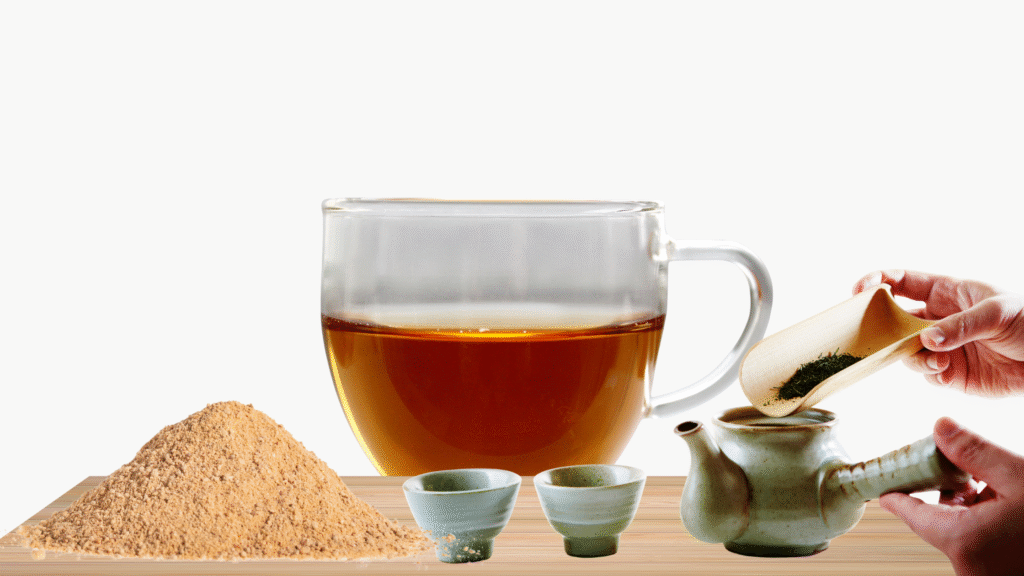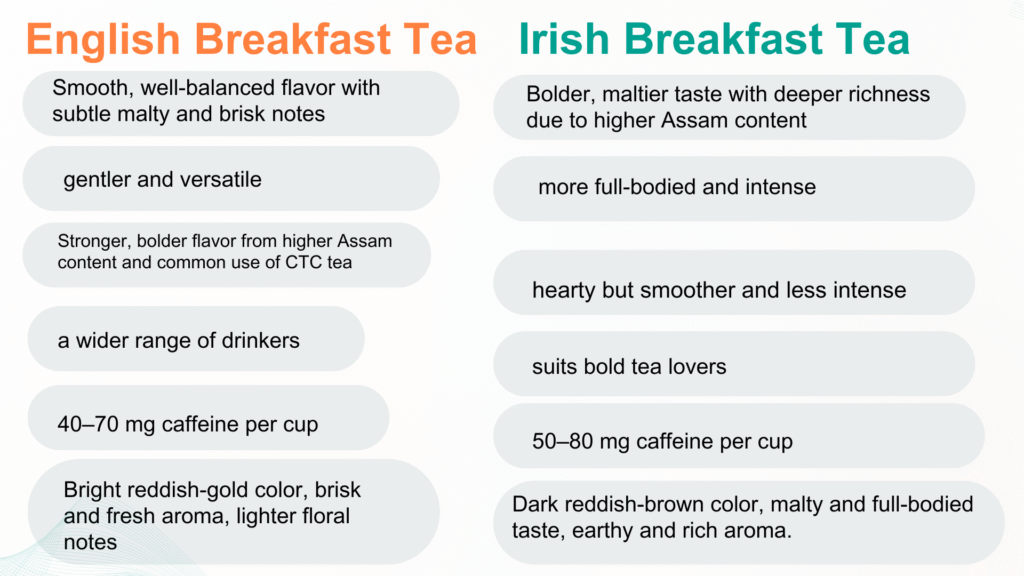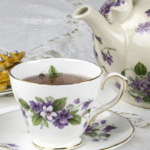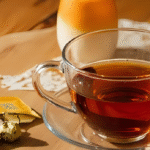English vs Irish Breakfast Tea, Which Is Better for you?

English vs Irish Breakfast Tea – Which Is Better? Discover flavor, strength, and caffeine differences to find the perfect morning brew. Without breakfast tea, the morning routine in Britain and Ireland has remained incomplete for over a century. These teas silently became a hearty and invigorating pair with a full breakfast. English breakfast tea emerged as a well-balanced option for starting the day in Britain. Across the Irish Sea, Irish breakfast tea evolved into a stronger, maltier blend. It caters to those who prefer a bolder kick in the morning.
Today, both blends remain beloved for their taste and role in tradition. The differences in breakfast tea are in strength, flavor, and composition: English breakfast is smoother and more rounded, while Irish breakfast leans toward strong black tea for morning energy, utilizing bold black tea blends. Whether you choose English for its balance or Irish for its punch, both offer a timeless start to the day.
English vs Irish Breakfast Tea – Which Is Better?
The key difference between English and Irish breakfast tea is strength and flavour. English breakfast tea is smooth, balanced, and slightly malty, perfect for a mild morning brew. On the other side, Irish breakfast tea is bolder, richer, and more malty, often stronger due to a higher Assam tea content. In short, Irish breakfast tea is more potent than English breakfast tea, while English breakfast tea offers a gentler, more rounded taste.
What Is Breakfast Tea?
Breakfast tea is a robust black tea blend traditionally enjoyed in the morning, providing flavour and energy to start the day. The concept originated in the UK during the 19th century, when tea merchants began creating more potent blends to pair perfectly with a hearty, cooked breakfast. Ireland soon developed its variation, favouring even bolder flavours.
Most breakfast teas are made from a combination of three main tea bases:
- Assam tea in breakfast blends – Rich, malty, and full-bodied, Assam from India is the backbone of many English and Irish breakfast teas.
- Ceylon tea breakfast blend – Bright, citrusy notes from Sri Lankan Ceylon tea add freshness and balance to the cup.
- Kenyan tea in breakfast tea – Known for its deep colour and brisk character, Kenyan black tea enhances strength and boldness.
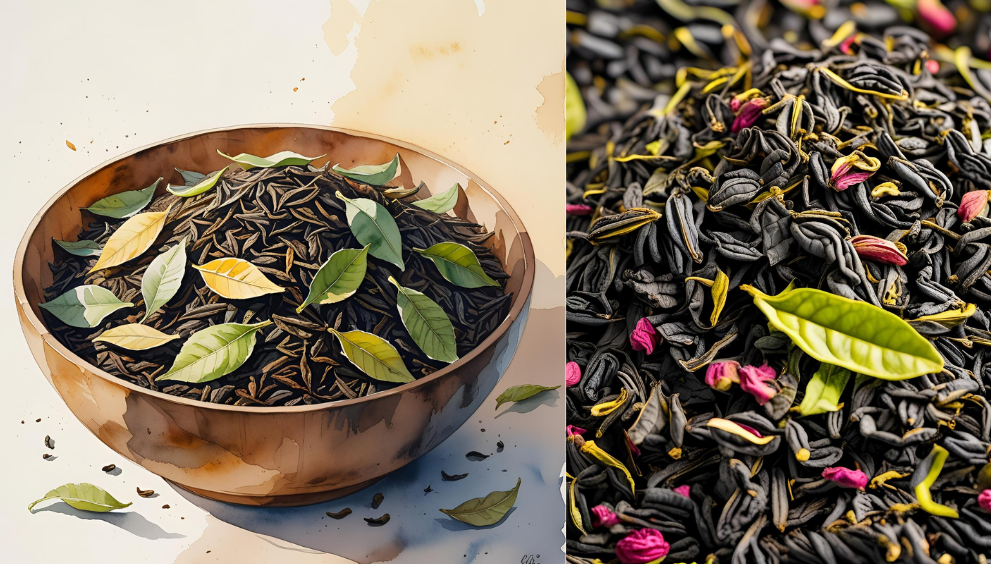
What is English breakfast tea?
Origin and history
It has roots in the 19th century; its exact origin is debated, with many crediting Scottish tea master Robert Drysdale with popularizing the blend in the late 1800s. Initially, the upper classes enjoyed it, but it became a staple across Britain for its rich yet approachable taste.
Flavor
English breakfast tea is a smooth black tea blend with a brisk taste. It offers malty notes and a hint of brightness, to make a versatile choice. This balance allows for enjoying plain or with milk and sugar, appealing to a wide range of tea drinkers.
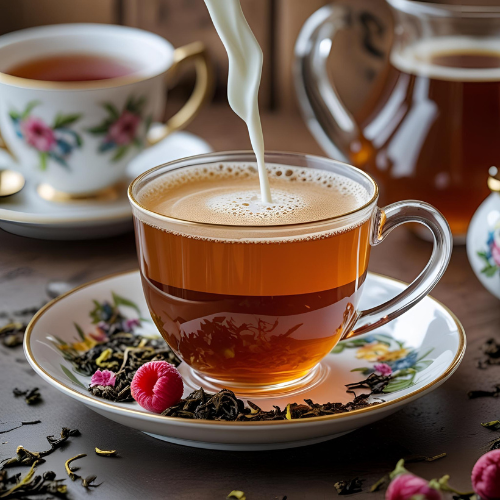
Common Tea Grades Used (CTC tea vs orthodox tea)
English breakfast blends often combine orthodox tea and CTC tea. This step helps to control bitterness for a strong cup. Orthodox leaves bring nuance, and CTC granules deliver a consistent boldness.
Popular Brands
- Twinings English Breakfast Tea is celebrated for its classic smoothness
- PG Tips Breakfast Tea, known for its rich, hearty character.
- Ahmad Tea, Yorkshire Tea, and Harney & Sons.
What is Irish breakfast tea?
Irish breakfast tea became popular in the late 19th and early 20th centuries, heavily influenced by Ireland’s preference for strong drinks. The concoction became a daily meal, especially in rural areas. Tea drinking is deeply embedded in Irish culture, and Irish breakfast tea remains a symbol of hospitality, served to guests not only in the morning but at any time of the day.
Flavor
Irish breakfast tea has a malty flavor and a robust breakfast tea character. It has a deep, reddish-brown liquor and a bold taste, often with a richer mouthfeel than its English counterpart. This strength comes from its high proportion of Assam tea, making it perfect for those who enjoy a powerful morning cup, especially with milk and sugar.
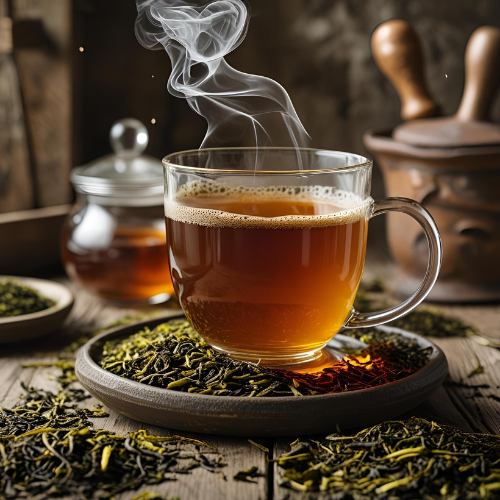
Common Tea Grades Used (CTC tea vs orthodox tea)
Most Irish breakfast blends rely heavily on CTC tea for a strong, brisk infusion and dark color. Orthodox leaves may be included in smaller amounts to add complexity, but the primary goal is boldness and consistency in flavor.
Popular Brands
- Barry’s Irish Breakfast Tea is known for its malty depth and strength.
- Best breakfast tea brands include Bewley’s, Thompson’s, and Twinings Irish Breakfast.
English vs Irish Breakfast Tea: Key Differences
Which Tea Grades Are Used in Breakfast Blends?
CTC vs Orthodox Processing Methods
Breakfast blends—English or Irish—often use a mix of CTC (Crush, Tear, Curl) and orthodox teas.
- CTC teas are made using machine processing for tiny pellets, brewing quickly into a strong, bold cup. They’re common in Irish breakfast blends for maximum strength.
- Orthodox teas are traditionally hand-rolled , giving a smoother, more nuanced flavor. These are more typical in English breakfast blends, although some premium Irish blends also use them for depth.
How Tea Grades Affect Flavor and Caffeine
- CTC tea grades produce a full-bodied, intense flavor and often slightly higher caffeine levels due to finer leaf particles.
- Orthodox tea grades steep more slowly, offering balanced flavor complexity with a gentler caffeine release.
- A blend with more CTC will generally taste stronger and have a brisker punch—perfect for those who like their tea with milk—while blends with more orthodox leaves lean toward refined, layered flavors.
How to Brew English and Irish Breakfast Tea
Loose Leaf vs Tea Bags (loose leaf breakfast tea vs tea bags)
- Loose leaf tea: Offers better aroma, richer flavor, and more nuanced taste, especially for premium blends. Both English and Irish breakfast teas shine when brewed with loose leaves.
- Tea bags: Convenient and quick, often made with CTC tea for a stronger and faster brew. Irish breakfast tea bags are generally bolder than English breakfast tea bags.
Steeping Temperature and Time (Irish breakfast tea steeping time)
- Water temperature: 95–100°C (203–212°F) for both types.
- Steeping time:
- English Breakfast Tea – 3–4 minutes for a smooth, balanced flavor.
- Irish Breakfast Tea – 4–5 minutes for a bold, malty cup.
- Longer steeping enhances strength but can add bitterness.
Serving Suggestions (English breakfast tea with milk, breakfast tea food pairing)
- Milk: Both teas pair well with milk, but Irish breakfast often needs more milk due to its strength.
- Sweeteners: Sugar or honey can soften bold flavors.
- Food pairing:
- English Breakfast Tea pairs with toast, eggs, and jam for a traditional British breakfast.
- Irish Breakfast Tea complements hearty dishes like bacon, sausage, or Irish soda bread.
How to Make Your Own English or Irish Breakfast Tea Blend
Choosing the Right Teas for Blending
- English Breakfast Tea: Typically blends Assam (malty, strong body), Ceylon (bright, citrusy notes), and sometimes Kenyan tea (bold, brisk).
- Irish Breakfast Tea: Dominated by Assam tea for richness, with Kenyan tea to boost strength and color. Rarely uses Ceylon, making it more malty and bold.
Ratios for Desired Taste and Caffeine
- Milder English Breakfast: 40% Assam + 40% Ceylon + 20% Kenyan.
- Bolder Irish Breakfast: 60% Assam + 40% Kenyan.
- Adjust the ratio depending on your caffeine preference — more Assam and Kenyan means higher caffeine and stronger flavor.
Storage Tips for Freshness
- Keep blends in an airtight, opaque container away from light, moisture, and strong odors.
- Store in a cool, dry place — avoid keeping it near spices or coffee.
For best flavor, use within 6–12 months of blending.
Health Benefits of Breakfast Teas
1. Antioxidants and Heart Health (black tea health benefits)
- English and Irish breakfast teas are rich in polyphenols like theaflavins and thearubigins, which help reduce oxidative stress.
- Regular consumption may improve blood vessel function, support heart health, and lower LDL cholesterol.
2. Energy Boost and Mental Clarity (tea for morning energy)
- Naturally contains caffeine for alertness without the jitters of coffee.
- The amino acid L-theanine promotes calm focus, making it ideal for productive mornings.
3. Digestive and Metabolic Support
- Black tea can stimulate healthy digestion and support metabolism.
- It may help regulate blood sugar levels and promote gut health due to beneficial plant compounds.
Conclusion – Which Should You Choose?
I explained everything about both teas. Now, it comes to English vs Irish breakfast tea, the choice boils down to personal preference:
- Taste Preference:
- Go for English Breakfast Tea if you prefer a smoother, milder flavor with a balanced briskness.
- Choose Irish Breakfast Tea if you enjoy a stronger, maltier, and more robust cup.
- Caffeine Needs:
- Irish breakfast tea has slightly more caffeine, making it ideal for a bigger morning energy boost.
- English breakfast tea is perfect for those who want a gentler lift.
- Food Pairing Habits:
- English breakfast tea pairs well with light breakfasts like toast, fruit, and pastries.
- Irish breakfast tea is better than hearty breakfasts like eggs, bacon, and sausage.
Choose Irish if you want a bold, wake-me-up brew. If you prefer a smooth, all-day drink, go for English.
Frequently Asked Questions
Does Irish or English breakfast tea have more caffeine?
Irish breakfast tea generally has slightly more caffeine because it often contains a higher proportion of Assam tea, which is naturally robust and energizing. This makes it a better morning “wake-up” choice, especially for those who prefer a more decisive kick to start the day.
What’s more potent than Irish breakfast tea?
Some strong builder’s tea, full-bodied loose-leaf Assam blends, or high-quality Kenyan black teas can surpass Irish breakfast tea in boldness and tannin strength. These teas deliver an intense, malty depth that even seasoned tea drinkers find powerful.
Do you put milk in Irish breakfast tea?
Yes. Irish breakfast tea’s malty, rich profile pairs beautifully with milk, making a smoother and creamier cup. People also add a small spoonful of sugar or honey to balance the tannins, especially if brewing it strong.
Which is better, English or Irish breakfast tea?
It depends on preference:
- English Breakfast Tea – Smoother, balanced, and slightly lighter; ideal for pairing with pastries or a mild breakfast.
- Irish Breakfast Tea – Stronger, maltier, and more robust; best for hearty breakfasts like a fry-up or buttered toast.
What is Scotland’s favorite tea?
Scottish Breakfast Tea is widely enjoyed, often more potent than Irish breakfast tea, with a brisk, malty taste designed to suit Scotland’s naturally soft water.
Is Irish Breakfast Tea anti-inflammatory?
Like most black teas, it contains polyphenols and catechins with antioxidant and mild anti-inflammatory benefits. While it’s not a medical treatment, regular consumption can support general wellness.
Do Irish people drink Irish Breakfast Tea?
Yes, in Ireland, it’s called “tea.” Popular household staples include Barry’s Gold Blend and Lyons Original Blend, which are enjoyed throughout the day, not just at breakfast.
What is the most popular breakfast tea?
Globally, English Breakfast Tea dominates due to its balanced flavor and adaptability. However, Barry’s Gold Blend remains Ireland’s reigning champion for daily tea drinkers.
How long should you steep Irish breakfast tea?
For a well-balanced cup, steep tea bags or loose-leaf Irish breakfast tea for 3–5 minutes in freshly boiled water. Longer steeping yields a more potent, more tannic brew.
Which Irish tea is best?
Barry’s Gold Blend and Lyons Tea are the most iconic, with Barry’s favored for its slightly bolder taste and Lyons preferred for its smoother finish. Both are considered must-try staples for visitors.
What do the Irish eat for lunch?
Typical lunches include fresh sandwiches, soup with soda bread, salads, hearty pub fare like stews, fish and chips, or shepherd’s pie — often accompanied by a strong cup of tea.


